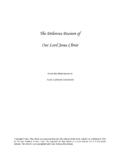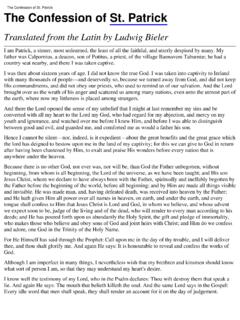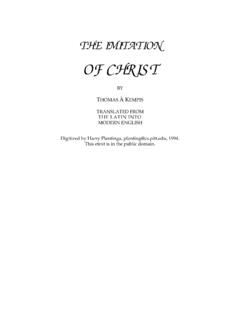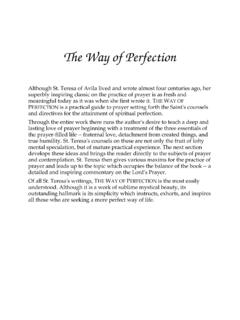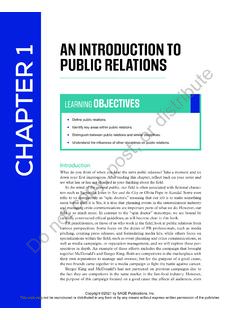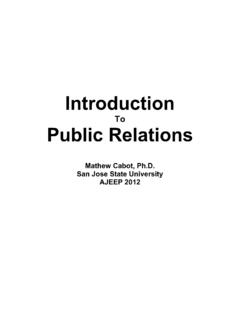Transcription of DIALOGUE OF SAINT CATHERINE OF SIENA Translated by …
1 THE DIALOGUE OF SAINT CATHERINE OF SIENAT ranslated by Algar Thorold"Man is placed above all creatures, and not beneath them, and he cannot be satisfiedor content except in something greater than himself. Greater than himself there isnothing but Myself, the Eternal God. Therefore I alone can satisfy him, and, becausehe is deprived of this satisfaction by his guilt, he remains in continual torment andpain. Weeping follows pain, and when he begins to weep, the wind strikes the treeof self-love, which he has made the principle of all his being." (Page 203). This workwas dictated by SAINT CATHERINE of SIENA during a state of ecstasy while in dialoguewith God the Father.
2 SAINT CATHERINE of SIENA (1347-1380) was declared a Doctor ofthe Church on October 4, DIALOGUE OF THE SERAPHIC VIRGINCATHERINE OF SIENADICTATED BY HER, WHILE IN A STATE OF ECSTASY,TO HER SECRETARIES, AND COMPLETEDIN THE YEAR OF OUR LORD 1370 TOGETHER WITHAN ACCOUNT OF HER DEATH BY AN EYE-WITNESSTRANSLATED FROM THE ORIGINAL ITALIAN, AND PRECEDED BY ANINTRODUCTION ON THE LIFE AND TIMES OF THE SAINT , BYALGAR THOROLDA NEW AND ABRIDGED EDITIONO riginally published in 1907 by Kegan Paul, Trench, Trubner & Co., Ltd., and edited by Harry Plantinga, language has been modernized by replacingthe archaic singular with the modern etext is in the public TREATISE OF DIVINE PROVIDENCEA TREATISE OF DISCRETIONA TREATISE OF PRAYERA TREATISE OF OBEDIENCE4 THE DIALOGUE OFST.
3 CATHERINE OF SIENAINTRODUCTIONIt would be hard to say whether the Age of the Saints, le moyen ge norme etd licat, has suffered more at the hands of friends or foes. It is at least certain that themedieval period affects those who approach it in the manner of a powerfulpersonality who may awaken love or hatred, but cannot be passed over withindifference. When the contempt of the eighteenth century for the subject, theresult of that century's lack of historic imagination, was thawed by the somewhatrhetorical enthusiasm of Chateaubriand and of the Romanticists beyond the Rhine,hostility gave place to an undiscriminating admiration.
4 The shadows fell out of thepicture; the medieval time became a golden age when heaven and earth visiblymingled, when Christian society reached the zenith of perfection which constitutedit a model for all succeeding ages. Then came the German professors with all theparaphernalia of scientific history, and, looking through their instruments, we, whoare not Germans, have come to take a more critical and, perhaps, a juster view ofthe matter. The Germans, too, have had disciples of other nations, and thoughconclusions on special points may differ, in every country now at a certain level ofeducation, the same views prevail as to the principles on which historicalinvestigation should be conducted.
5 And yet, while no one with a reputation to losewould venture on any personal heresy as to the standards of legitimate evidence,the same facts still seem to lead different minds to differing appreciations. Forhistory, written solely ad narrandum, is not history; the historian's task is not overwhen he has disinterred facts and established dates: it is then that the most delicatepart of his work begins. History, to be worthy of the name, must produce theillusion of living men and women, and, in order to do this successfully, must bebased, not only upon insight into human nature in general, but also upon personalappreciation of the particular men and women engaged in the episodes with whichit deals.
6 With facts as such, there can indeed be no tampering; but for thedetermination of their significance, of their value, as illustrative of a course ofpolicy or of the character of those who were responsible for their occurrence, wehave to depend in great measure on the personality of the historian. It is evidentthat a man who lacks the sympathetic power to enter into the character that heattempts to delineate, will hardly be able to make that character live for us. For inArt as well as Life, sympathy is , while this is true of all history whatever, it is perhaps truer of the history ofthe middle ages than of that of any more recent period, nor is the reason of this far5to seek.
7 The middle ages were a period fruitful in great individuals who moldedsociety, to an extent that perhaps no succeeding period has been. In modern timesthe formula, an abstraction such as "Capital" or the "Rights of Man" has largelytaken the place of the individual as a plastic force. The one great Tyrant of thenineteenth century found his opportunity in the anarchy which followed theFrench Revolution. The spoil was then necessarily to the strong. But evenNapoleon was conquered at last rather by a conspiracy of the slowly developinganonymous forces of his time than by the superior skill or strength of an individualrival.
8 The lion could hardly have been caught in such meshes in the trecento. Then,the fate of populations was bound up with the animosities of princes, and, in orderto understand the state of Europe at any particular moment of that period, it isnecessary to understand the state of soul of the individuals who happened, at thetime, to be the political must not be thought, however, that the personality of the prince was the onlypower in the medieval state, for the prince himself was held to be ultimatelyamenable to an idea, which so infinitely transcended earthly distinctions as to levelthem all in relation to itself.
9 Religion was in those days a mental and social forcewhich we, in spite of the petulant acerbity of modern theological controversies,have difficulty in realizing. Prince and serf would one day appear as suppliantsbefore the Judgment-seat of Christ, and the theory of medieval Christianity wasconsiderably in favor of the serf. The Father of Christendom, at once Priest andKing, anointed and consecrated as the social exponent of the Divine Justice, couldnot, in his own person, escape its rigors, but must, one day, render an account of hisstewardship. Nor did the medieval mind, distinguishing between the office and theindividual, by any means shrink from contemplating the fate of the faithlesssteward.
10 In a "Last Judgment" by Angelico at Florence, the ministers of justice seemto have a special joy in hurrying off to the pit popes and cardinals and it is an insufficient criticism that has led some to suppose that the medievalChurch weighed on the conscience of Christendom solely, or even primarily, as anarbitrary fact: that the priesthood, aided by the ignorance of the people, succeeded inestablishing a monstrous claim to control the destinies of the soul by quasi-magicalagencies and the powers of excommunication. Nothing can be further from thetruth. Probably at no period has the Christian conscience realized more profoundlythat the whole external fabric of Catholicism, its sacraments, its priesthood, itsdiscipline, was but the phenomenal expression, necessary and sacred in its place, ofthe Idea of Christianity, that the vitality of that Idea was the life by which theChurch lived, and that by that Idea all Christians, priests as well as laymen, rulers aswell as subjects, would at the last be judged.
